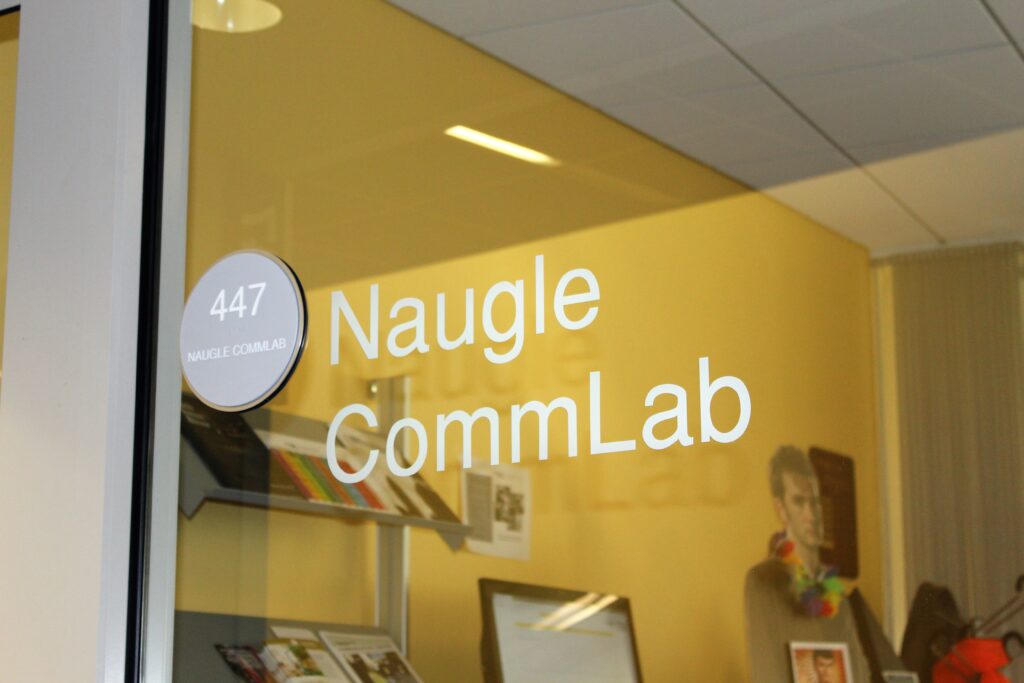
The Naugle Communication Center (CommLab) is a student support organization located in CULC 447. It specializes in providing opportunities for Georgia Tech students to meet one-on-one with consultants and receive feedback on personal, professional, and academic communication-related projects.
by Genny Onyiuke-Kennedy, Emily Nguyen, Stephanie Oliva, Raneem Rizvi, Rocio Soto, Sophia Tone, Jeff Howard, and Eric Lewis
This article is the first installment of a two-part series relating the views of six peer consultants who have worked at the Naugle Communication Center during its transition from in-person/face-to-face consultations to online consultations in response to the COVID-19 pandemic. This installment provides an introductory discussion of the scholarship regarding online consultations in a writing center context and the peer consultants’ views on working online versus in-person.
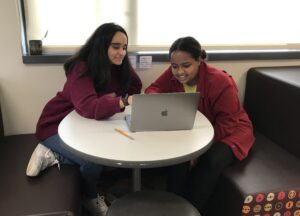
Communication consultants at work in the Center. Photo taken by Cassidy Reese, 2019.
The COVID-19 pandemic has required most academic institutions to adapt the way they have traditionally served students and met their objectives. One of the most salient procedural shifts is the mediation of videoconferencing technologies and platforms, including BlueJeans and Microsoft Teams. Among the many on-campus departments and services affected by the pandemic is Georgia Tech’s Naugle Communication Center (located in CULC 447). The Center, also known as the Naugle CommLab, provides students with opportunities for one-on-one and group consultations with peer and professional communication specialists on communication-related projects. Peer consultants are Georgia Tech undergraduate students hired because of their excellent communication and people skills; professional consultants are postdoctoral fellows who teach in the Writing and Communication Program as well as work in the Center.
Because of social distancing guidelines and the necessity of protecting both consultants and clients from exposure, in March 2020 the Center made a necessary and abrupt transition from its traditional face-to-face consultations in a physical space to asynchronous and synchronous consultations in a digital space. The interview excerpts below present insights on the transition from in-person consultations to online consultations as expressed by peer consultants in the Naugle Communication Center: Genny Onyiuke-Kennedy, Emily Nguyen, Stephanie Oliva, Raneem Rizvi, and Sophia Tone.
The Center has developed easy-to-follow guidelines to streamline the process of making appointments, transferring files, and retrieving feedback. For asynchronous appointments at the Center, students upload the file they want feedback on to TutorTrac, the Center’s appointment management system, and answer questions asking them to set the consultation agenda. Their consultant then accesses the file and reviews it during the appointment. The consultant provides written feedback, which they will then upload in or with the file upon completing the appointment. Students can then retrieve their feedback. For synchronous appointments, students must still upload their file before the appointment so that their consultant can have direct access to it, but the appointment itself takes place over BlueJeans. In these BlueJeans appointments, students and consultants have conversations about the student’s work. Both the student and consultant can make notes about things they discuss, and afterwards the consultant makes their feedback available to the student on TutorTrac.
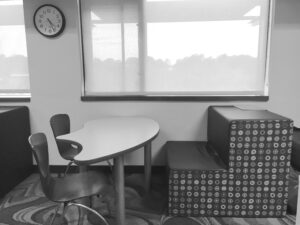
Currently, the Center is providing consultation services through asynchronous and synchronous appointments.
Initially a response to risk, the decision to shift to online asynchronous and synchronous consultations, was also informed by a need for greater flexibility, accessibility and potential technological issues. While online consultations offer a new format for the work done in this particular Center, the practice of online consultations in writing centers is not new. Such online services have existed and become established in the academy for many years.
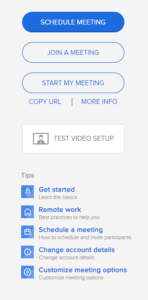
The Communication Center uses the videoconferencing platform BlueJeans for its online synchronous appointments.
Throughout much of its long history, the idea of online tutoring, especially in asynchronous modalities, was viewed skeptically by writing/communication center administrators and scholars because it seems to depart from some foundational views of the writing/communication center and its function. In “The Idea of a Writing Center,” Stephen North challenges the notion of the writing center as “fix-it shop,” to which a student drops off a paper that is returned to them fixed by the consultant (435–37). North also emphasizes that dialogue is essential to a writing center’s function (443). When performed online, especially asynchronously, the nature of communication between consultant and client changes. Is an exchange of notes that constitutes an asynchronous consultation dialogue, in the sense that North uses the term? In similarly foundational texts, Andrea Lunsford and Jeff Brooks argue for the importance of collaboration and hands-off global feedback—two things often lessened by asynchronous online consultation because the consultant works in isolation with the document rather than engaging, conversing, and negotiating with the client. Online consultation can change how writing/communication centers function; the question is whether it changes to such an extent as to hinder the center’s effectiveness or impact.
Even when embraced, online tutoring has frequently been framed in terms of its exigency, but this attitude has undermined its legitimacy as a regular practice. As early as 2000, Muriel Harris predicted that “online options” for tutoring might eventually need to become a commonplace if writing centers were going to evolve with changes in technology and technical knowledge that students would bring to and develop at the university. However, that prediction had more to do with being perceived as relevant and useful to those future students than it was interested in acknowledging the additional affordances to be gained from online tutoring as a practice (14). For many people in writing center studies, online tutoring has been viewed as inferior in contrast to traditional face-to-face tutoring, and it is a practice that can be turned to when necessary, whether for reasons of accessibility and outreach or, in a pandemic, for the purpose of ensuring the safety and health of consultants and clients (Hewett 2).

The Bedford Guide for Writing Tutors is commonly used as a reference guide for new communication consultants, providing a number of strategies for more effective online consultations.
In other circles of writing center work, online consulting has become more than a practice to be relied on only when absolutely necessary. Rather, online consulting is an established format for doing writing center work that exists alongside face-to-face consulting as an alternative but still valuable and highly functional way of offering writing center services to as many students as possible. Anecdotal evidence drawn from our own practice and the extant literature on the practice shows that online consultations can be an extremely effective avenue for our field of academic support. For example, The Longman Guide to Peer Tutoring by Paula Gillespie and Neal Lerner and The Bedford Guide for Writing Tutors by Leigh Ryan and Lisa Zimmerelli, both frequently used texts in the training and enculturation of new communication consultants, seek to normalize online tutoring, both asynchronous/“offline” and synchronous/“online” modes (Ryan and Zimmerelli 89–92; Gillespie and Lerner 161–6). They explore the potential pitfalls and benefits of each, as well as strategies that can help consultants make their online consultations an effective learning experience for clients. In addition to sponsoring the usefulness of online consultation, especially asynchronous, Kathryn Denton has argued for the usefulness of and need for greater research about both. As centers employ online modes of consultations and continually assess their procedures and outcomes, their ability to meet clients’ needs in an online setting will be augmented.
Learning to consult online is more than simply applying strategies learned in training sessions, although, as the CCCC’s position statement on Online Writing Instruction (OWI) states, it is of course vital that “Online writing lab administrators and tutors should undergo selection, training, and ongoing professional development activities that match the environment in which they will work” (“Position Statement”). Online consultation requires that consultants, through their own experiences, become familiar and comfortable within the new medium and adapt their tutoring style in a way that fits with and takes advantage of the affordances of the online tutoring environment. These interviews, broken into a two-part series, reflect the views and experiences of six consultants, with varying levels of experience, as they adjusted to consulting online. They also reflected on what they think the future of communication center work might look like because of their experiences with asynchronous and synchronous consultations during the COVID-19 pandemic.
~Jeff Howard and Eric Lewis
Before COVID-19, had you ever given any thought to the idea of online consulting? Did you see it as something the CommLab ought to be doing? Why?

Genny Onyiuke-Kennedy
Genny Onyiuke-Kennedy: Prior to COVID-19, I wanted online consulting to be an option, and that’s why I did a bit of work on it. But I was angling for it to be a side option rather than a main option. There’s a pretty strong emphasis, understandably, on bringing people in [to the CommLab] because there is value in face-to-face communication. To maximize that for something as obvious as communication, which is what we’re working on, it just makes sense. I had wanted online consulting to be an option in situations where it just wasn’t really fair or possible for somebody to be able to physically make it to the CommLab, while still encouraging that face-to-face interaction. I thought online consulting had a place, but I didn’t want it to be the spotlight.
Emily Nguyen: I remember reading through The Bedford Guide for Writing Tutors. And I thought, after reading the whole section about online consulting, “Oh, that is pretty cool.” And I wondered why we didn’t do it. But at the time, it felt like, well, maybe this is more convenient for students at Georgia Tech. But then, once COVID–19 hit, I was like, “Oh, my gosh, we absolutely should, in the future, offer both because there’s definitely students that benefit from both formats.”

Stephanie Oliva
Stephanie Oliva: It was something that I actually considered in previous semesters. I think that it’s a generally helpful tool to be able to speak with someone about your assignments online. Students can’t always make it in to an in-person appointment depending on workload and other factors. I definitely think it’s something that the CommLab should keep up after COVID-19 has subsided.
Raneem Rizvi: I’d never thought to do it online. But online stuff has been saving a lot of time in general for meetings and everything, which I would have never even thought possible. The online asynchronous ones could be very useful, even moving past COVID-19, just because, if we’re sitting there not really doing anything in the CommLab, we could just be working on an asynchronous appointment. And I feel like it would help a lot of people that aren’t on campus or don’t have time to come in for an appointment. Even though it seems sad that we don’t get to go into the CommLab, I think there are a lot of pros coming out of working from home and being able to do appointments for people that don’t have the accessibility to come in.
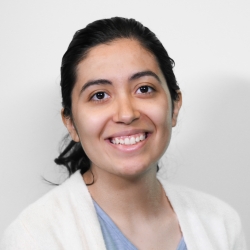
Rocio Soto
Rocio Soto: This is something that some of us consultants have been talking about for a while. We were actually trying things out, because we [Rocio, Genny, and Sophia] were part of the Inclusivity and Outreach Team together. And one of our ways to outreach was to make things more accessible. We were testing out stuff last year, but I think our admin was a little hesitant, and rightly so, because there’s a lot that goes on and a lot that changes with online consultations. We were still very much not prepared [when the pandemic happened]. We had always thought about it potentially being a good idea.
Sophia Tone: I was a part of the Inclusivity and Outreach Committee in the CommLab, and one of our pet projects was the creation of an online consulting platform. I think the general sentiment was that virtual consulting would be useful, but too complicated to set up and maintain. We did a couple of test runs on various applications, but we constantly ran into logistical issues and decided that an online platform wasn’t our priority (because when would people need to virtually work? Never in a million years!). Ironically, it was only a few weeks later when the entire country shut down and online CommLab became its beautiful self.
What are your thoughts on the comparative affordances of face-to-face vs. online consulting? Contrasting these two modes, what does each do better than the other?

Raneem Rizvi
Raneem: I really miss being in the CommLab, interacting with people. I had a BlueJeans [appointment] today, and usually, they don’t have their camera turned on. It kind of takes away that whole aspect of being able to see them and talk to them, and obviously, I’m not going to force them to turn the camera on. And then, the asynchronous ones, I find those kind of nice, honestly. Because I have the time to think through it and not be worried about what they’re thinking or being worried about if they’re understanding what I’m saying. And I could just kind of go through it at my own pace. But the BlueJeans ones—I would say I miss being in–person. Look, there’ll also be the lag on BlueJeans where they’re sharing the screen and trying to show something, and I don’t know what they’re talking about. In general, I really miss being in–person, but it hasn’t been too bad. I’m not like, “Oh, I hate this so much.” It’s been like, “I’m glad we can work from home, and we can still help people.”

Emily Nguyen
Emily: Oh my gosh, it’s just so much nicer to have some facial feedback. And I really try to be more humorous with my clients. You can’t really express that in an asynchronous appointment. Like typing out “haha” doesn’t really translate. And there’s also a part of me that wonders, if I type “haha,” will this ruin my professional credibility?
It works well on BlueJeans. The one thing about BlueJeans I don’t like is that the connection is rough. And also, BlueJeans is kind of rough. But it’s so useful to have the ability to just see if they’re squirming or not. “Are you comfortable with the things that I’m proposing? Does this make sense to you?” Even if sometimes they’ll say, “Yeah, I think it makes sense,” I’m like, “Okay, now I’m gonna go over this again. I don’t think you got it.”
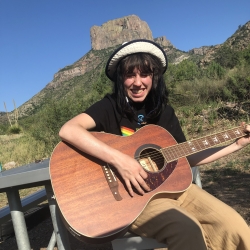
Sophia Tone
Sophia: I think face-to-face consulting gives each person a much wider appreciation of the other. When CommLab was in–person, I could get to know my client, if only for a few minutes, before diving into the session. By exchanging interests, backgrounds, or just complaining about our current workloads, we were able to create an open space that felt safe and trusting. I think this safe space made the actual consulting easier. We understood each other a little, and were therefore more receptive to the other than two people can be via online consulting. We could have a relaxed conversation with humor and sarcasm and all the things that go into two-way discourse that just isn’t possible on a Word document. The personable aspect of face-to-face consulting is something that can’t be replaced with online consulting. Video-sharing platforms are a step closer to in-person consulting, but even they obscure personality because of lag time and blurry or poorly-lit video.
The upside with online consulting is the increased attention that I’m able to give each appointment. I’m able to sit and think about the text by myself. I don’t have to directly engage with the client, which removes the pressure to placate them and to water down my feedback. I find that my feedback is stronger and clearer than what I’d give in–person.
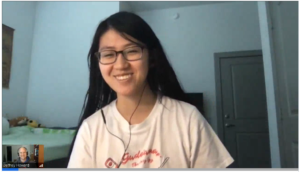
Synchronous appointments through BlueJeans allow communication consultants to interact with clients in ways that resemble the immediacy and dynamics of an in-person consultation.
Stephanie: I generally prefer face-to-face consulting. I think it adds an extra level of understanding and perspective between the student client and the consultant that isn’t present when an appointment is asynchronous. I think making the student feel comfortable about speaking about their work in–person gives me greater perspective as the consultant and allows me to provide more precise feedback regarding their concerns and explanations/discussions as to why I have made particular suggestions.
Genny: Online consulting is more accessible and more attuned to the client’s time and scheduling because they don’t have to budget for actually being in CommLab. Other than that, I think online consulting might be more comfortable for people. Let’s say they’re practicing an interview, and I’m asking them questions, and they want to answer. Maybe for them, even if they came in, it’s just early, and they just want to get warmed up. They don’t feel superconscious about themselves because they might be dressed more casually, or they might feel more at home, or they physically are [at home]. I think that level of comfort sometimes can be difficult to achieve when they’re in a foreign area with a foreign person. I guess if one of those things is familiar, it could be helpful. I remember [consulting for] a bunch of commencement speeches, and helping people out with those is so important to do in–person. The reason is because there’s so many things that you might not catch digitally, that you would catch in–person, like mannerisms and stuff. One, because of connectivity issues online, but also, I mean, there’s so many subtle things that change your message entirely, and you’re able to catch that easier in person.
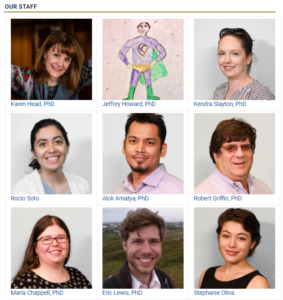
The consultants at the Communication Center pride themselves on creating a welcoming and friendly atmosphere in face-to-face and online appointments.
We thought that person-to-person interaction was important before COVID-19, but now we know that it’s like, wow, we are social animals. And since CommLab has a group of absolutely welcoming people with smiling faces, there really are a few things better when it comes to being assisted by somebody who is willing to go at your own pace, in–person, speak very warmly to you, and encourage you along the way. It’s a process that you can invest in physically, and you can come away with a very real interaction with another person that can be enriching.
Another thing we do is that we don’t want people to come to the CommLab like 20 times. We want them to come, you know, a couple of times and, you know, be able to learn things. That’s why we don’t tell them, “Hey, do this.” We tell them, “Hey, what are you trying to convey here? You might want to try looking up different vocabulary or changing your sentence structure,” etc. Those sorts of things. I think that it’s less likely that someone’s going to be coming back again and again, if we meet them in–person and are able to imbue not only new knowledge, but also a sense of confidence, because once again, that really does make all the difference with communication.
Rocio: [With online consulting], it’s very easy to manage your time. That’s very nice, at least from a consultant perspective. And I’m sure from a student perspective, not having to walk down to the CULC or commute down to campus, that’s nice as well. It is a lot more accessible. However, I will say, there’s always just a lot of technical stuff going on, you know, and sometimes someone else’s feedback isn’t super great, or their connection isn’t super great. Or we take a couple minutes to try to share screens, pull up docs, and there are these items and these things where you just need that physical copy to really streamline the process. Sometimes you’re like, “Okay, we’ll try our best to share the screen. Oh, it doesn’t work. Oh, it’s paused.” There’s a lot of that technical backlog. For me, I think that’s one of the toughest things with going online. And just like with the asynchronous [appointments], it kind of depends on how much information the student client gives you to start.
Do you prefer consulting online or face–to–face?
Sophia: I thought I would hate online consulting, but I actually think I prefer it.
Emily: I would definitely do face-to-face. Oh, gosh, I recently actually had a BlueJeans appointment where it was just awkward silence for a while. I do not miss that.
Stephanie: I don’t mind online consulting, but I do prefer face-to-face consulting. In a COVID-19-less future I’d like to offer a mix of both to best accommodate student needs.
Genny: Face-to-face.
Raneem: I don’t know. I personally like face-to-face just because I can communicate a lot easier, and [the Internet connection] doesn’t have to be an issue and stuff like that. I don’t know. There are definitely pros and cons to both. I can just be working from home. And if I have a class, I can literally just log on right after. I don’t have to walk to the CULC. But there’s definitely something good about the in-person thing and being in the Center.
Works Cited
Brooks, Jeff. “Minimalist Tutoring: Making the Student Do All the Work.” Writing Lab Newsletter, vol. 15, no. 6, 1991, pp. 1-4.
CCCC. “A Position Statement of Principles and Example Effective Practices for Online Writing Instruction (OWI).” Conference on College Composition and Communication, 14 Aug. 2018, cccc.ncte.org/cccc/resources/positions/owiprinciples.
Denton, Kathryn. “Beyond the Lore: A Case for Asynchronous Online Tutoring Research.” The Writing Center Journal, vol. 36, no. 2, 2017, pp. 175-203. JSTOR, https://www.jstor.org/stable/44594855.
Gillespie, Paula, and Lerner, Neal. The Longman Guide to Peer Tutoring. Second ed. Pearson/Longman, 2008.
Harris, Muriel. “Preparing to Sit at the Head Table: Maintaining Writing Center Viability in the Twenty-First Century.” The Writing Center Journal, vol. 20, no. 2, 2000, pp. 13-22. JSTOR, https://www.jstor.org/stable/43442095.
Hewett, Beth L. The Online Writing Conference: A Guide for Teachers and Tutors. Bedford/St. Martin’s, 2015.
Lunsford, Andrea A. “Collaboration, Control, and the Idea of a Writing Center.” Writing Center Journal, vol. 12, no. 1, 1991, pp. 3-10.
North, Stephen M. “The Idea of a Writing Center.” College English, vol. 46, no. 5, 1984, pp. 433-46. JSTOR, https://www.jstor.org/stable/377047.
Ryan, Leigh, and Zimmerelli, Lisa. The Bedford Guide for Writing Tutors. Sixth ed. Bedford/ St. Martin’s, 2016.
